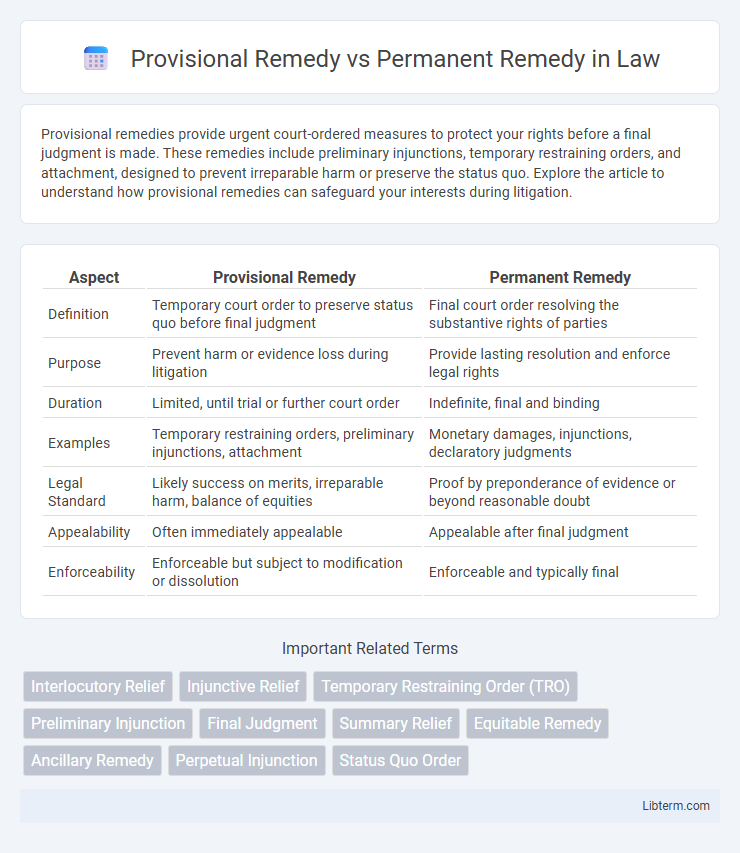Provisional remedies provide urgent court-ordered measures to protect your rights before a final judgment is made. These remedies include preliminary injunctions, temporary restraining orders, and attachment, designed to prevent irreparable harm or preserve the status quo. Explore the article to understand how provisional remedies can safeguard your interests during litigation.
Table of Comparison
| Aspect | Provisional Remedy | Permanent Remedy |
|---|---|---|
| Definition | Temporary court order to preserve status quo before final judgment | Final court order resolving the substantive rights of parties |
| Purpose | Prevent harm or evidence loss during litigation | Provide lasting resolution and enforce legal rights |
| Duration | Limited, until trial or further court order | Indefinite, final and binding |
| Examples | Temporary restraining orders, preliminary injunctions, attachment | Monetary damages, injunctions, declaratory judgments |
| Legal Standard | Likely success on merits, irreparable harm, balance of equities | Proof by preponderance of evidence or beyond reasonable doubt |
| Appealability | Often immediately appealable | Appealable after final judgment |
| Enforceability | Enforceable but subject to modification or dissolution | Enforceable and typically final |
Understanding Provisional Remedies
Provisional remedies are temporary court orders designed to preserve the status quo or protect assets during the litigation process, preventing irreparable harm before a final judgment is reached. These remedies include injunctions, attachment, garnishment, and receiverships, which provide immediate but short-term relief to parties in urgent need. Understanding provisional remedies is essential for litigants to secure timely protection while awaiting a permanent remedy that resolves the substantive issues of the case.
Defining Permanent Remedies
Permanent remedies are legal solutions granted by courts that provide lasting relief and final resolution to a dispute, often in the form of injunctions, damages, or specific performance. Unlike provisional remedies, which are temporary measures designed to protect parties' interests during litigation, permanent remedies settle the underlying issue after a full hearing on the merits. Courts award permanent remedies only after evaluating all evidence and legal principles to ensure fair and equitable enforcement of rights.
Key Differences Between Provisional and Permanent Remedies
Provisional remedies are temporary court orders designed to preserve the status quo and prevent irreparable harm before a final judgment, such as temporary restraining orders or preliminary injunctions. Permanent remedies are final court decisions that fully resolve the legal dispute, including damages awards, permanent injunctions, or specific performance. The key difference lies in their duration and purpose: provisional remedies provide interim relief during litigation, whereas permanent remedies provide conclusive and enforceable resolution after trial.
Legal Grounds for Provisional Remedies
Provisional remedies are granted based on the immediate risk of irreparable harm and the likelihood of success on the merits, aiming to preserve the status quo until a final decision is reached. These remedies require credible evidence that delaying relief would cause significant damage that cannot be adequately compensated by money alone. Courts evaluate factors such as the urgency of the situation, balance of harms, and public interest when deciding whether to issue provisional relief before trial or final adjudication.
Legal Grounds for Permanent Remedies
Permanent remedies require clear legal grounds such as proven entitlement to relief based on established rights, final adjudication of the issues, and demonstrated inadequacy of monetary damages. Courts grant permanent remedies when the plaintiff shows a substantial likelihood of ongoing harm that can't be addressed by temporary measures or compensation alone. Legal standards for permanent remedies include equity principles, proof of irreparable injury, and the balance of hardships favoring the party seeking relief.
Typical Examples of Provisional Remedies
Typical examples of provisional remedies include temporary restraining orders, preliminary injunctions, and attachment orders, which serve to preserve the status quo or prevent harm before a final judgment is rendered. These remedies are crucial in urgent circumstances to protect assets, prevent the dissipation of property, or maintain ongoing rights during litigation. Provisional remedies differ from permanent remedies in that they are temporary and designed to ensure effective enforcement of eventual court decisions.
Common Types of Permanent Remedies
Permanent remedies in law are court-ordered solutions that fully resolve a legal dispute and provide lasting relief, unlike provisional remedies which offer temporary protection. Common types of permanent remedies include damages, which compensate for loss or injury; injunctions, which require a party to do or refrain from specific actions; and specific performance, mandating the fulfillment of contractual obligations. These remedies are designed to provide finality and certainty in legal outcomes, ensuring that the rights of parties are upheld effectively.
When to Seek Provisional vs Permanent Remedies
Provisional remedies are sought early in legal proceedings to preserve the status quo, protect assets, or prevent harm before a final decision is reached, making them essential in urgent situations requiring immediate court intervention. Permanent remedies are pursued after a full trial or hearing, providing final, enforceable relief that resolves the main issues of a case based on the evidence and legal merits. Choosing between provisional and permanent remedies depends on the timing and necessity of immediate protection versus long-term resolution of legal disputes.
Impact of Remedies on Legal Proceedings
Provisional remedies provide temporary relief during legal proceedings, helping to preserve the status quo and prevent irreparable harm until a final decision is reached. Permanent remedies offer conclusive relief, resolving the underlying dispute and establishing enforceable rights or obligations. The impact on legal proceedings is significant, as provisional remedies can expedite resolution by maintaining balance, while permanent remedies bring finality and closure to the case.
Choosing the Right Remedy: Factors to Consider
Choosing between a provisional remedy and a permanent remedy requires evaluating the urgency of relief needed and the potential impact on the parties involved. Provisional remedies, such as temporary restraining orders or preliminary injunctions, offer immediate but short-term protection to prevent irreparable harm before a full trial. Permanent remedies are decided after a thorough examination of evidence and legal arguments, providing long-term resolution and enforceable judgments tailored to the final outcome of the case.
Provisional Remedy Infographic

 libterm.com
libterm.com